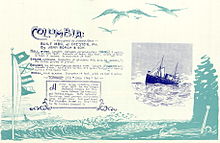 Photograph of SS Columbia under way
| |
| History | |
|---|---|
| Name | Columbia |
| Owner |
|
| Operator | |
| Port of registry | |
| Route | San Francisco, California to Portland, Oregon via Astoria, Oregon[3] |
| Ordered | July 1879 |
| Builder | Delaware River Iron Ship Building and Engine Works (Chester, PA)[4] |
| Cost | US $450,000 in 1880[5] |
| Yard number | 193[6] |
| Laid down | September 1879 |
| Launched | 24 February 1880[7] |
| Completed | May 1880 |
| Maiden voyage | June 1880[8] |
| In service | 1880–1907 |
| Out of service | 21 July 1907[7] |
| Fate | Sunk, 21 July 1907, Shelter Cove, California |
| Notes | Collided with the lumber schooner San Pedro |
| General characteristics | |
| Tonnage | 2,721 tons |
| Length | 332 ft (101 m) (309 ft (94 m) below the waterline) |
| Beam | 38.5 ft (12 m) |
| Draft | 18 ft (5.5 m) |
| Depth | 23 ft (7.0 m) |
| Decks | 4 |
| Installed power | Six cylindrical 12 ft (3.7 m) diameter 12.5 ft (3.8 m) long boilers, powering two 42.5 in (1,080 mm) and 82 in (2,100 mm) by 54 in (1,400 mm) stroke compound condensing engines |
| Propulsion | Single four bladed 16 ft (4.9 m) diameter Hirsch propeller |
| Sail plan | Brigantine[9][10] |
| Speed | 16 kn (18 mph; 30 km/h) |
| Capacity | 382 to 850 first class and steerage passengers |
| Notes | The first ship to use electric light bulbs, and the first use besides Edison's lab of electric light.[7] Columbia was equipped with four watertight bulkheads. It also featured eight metal lifeboats, one wooden lifeboat, one wooden workboat, five life rafts and 537 life preservers.
 |
SS Columbia (1880–1907) was a cargo and passenger steamship that was owned by the Oregon Railway and Navigation Company and later the San Francisco and Portland Steamship Company. Columbia was constructed in 1880 by the John Roach & Sons shipyard in Chester, Pennsylvania for the Oregon Railway and Navigation Company.[7]
Columbia was the first ship to carry a dynamo powering electric lights instead of oil lamps and the first commercial use of electric light bulbs outside of Thomas Edison's Menlo Park, New Jersey laboratory.[7][11][12] Due to this, a detailed article and composite illustration of Columbia was featured in the May 1880 issue of Scientific American magazine.[13]
Columbia was lost on 21 July 1907 after a collision with the lumber schooner San Pedro off Shelter Cove, California, with the loss of 88 lives.[14]
- ^ Deumling, Dietrich (1972). The roles of the railroad in the development of the Grande Ronde Valley (M.A.). Flagstaff: Northern Arizona University. OCLC 4383986.
- ^ Ringwalt, John Luther (1888). Development of Transportation Systems in the United States: Comprising a Comprehensive Description of the Leading Features of Advancement, from the Colonial Era to the Present Time, in Water Channels, Roads, Turnpikes, Canals, Railways, Vessels, Vehicles, Cars and Locomotives. author, Railway World Office. p. 290. Retrieved September 8, 2013.
{{cite book}}:|work=ignored (help) - ^ "San Francisco Call, Volume 102, Number 30". Re-printed. San Francisco, California. California Digital Newspaper Collection. June 30, 1907. p. 49. Retrieved August 17, 2013.
- ^ Colton, Tim (August 4, 2010). "The Delaware River Iron Shipbuilding & Engine Works, Chester PA". Original. Shipbuilding History: Construction records of U.S. and Canadian shipbuilders and boatbuilders. Archived from the original on May 10, 2012. Retrieved September 8, 2013.
- ^ Annual Report of the Board of Directors of the Oregon Railway and Navigation Co. to the Stockholders Volumes 1–8. Oregon Railway and Navigation Company. 1880. Retrieved July 24, 2015.
- ^ "The Delaware River Iron Shipbuilding & Engine Works, Chester PA". Original. Shipbuilding History. Archived from the original on October 23, 2014. Retrieved October 7, 2013.
- ^ a b c d e Jehl, Francis (2002). Menlo Park reminiscences : written in Edison's restored Menlo Park laboratory. Whitefish, Mass: Kessinger Publishing. p. 564. ISBN 9780766126480.
- ^ Cite error: The named reference
WRA1was invoked but never defined (see the help page). - ^ "Brigantine (noun)". Dictionary. Merriam Webster. Retrieved October 27, 2013.
- ^ Antonio Jacobsen (1880). "SS Columbia". Archive. Retrieved October 27, 2013 – via The Athenaeum.
- ^ Cite error: The named reference
Revolutionwas invoked but never defined (see the help page). - ^ Cite error: The named reference
GEwas invoked but never defined (see the help page). - ^ Cite error: The named reference
Scientific Americanwas invoked but never defined (see the help page). - ^ Dalton, Anthony A long, dangerous coastline : shipwreck tales from Alaska to California, Heritage House Publishing Company, 2011, 128 pages